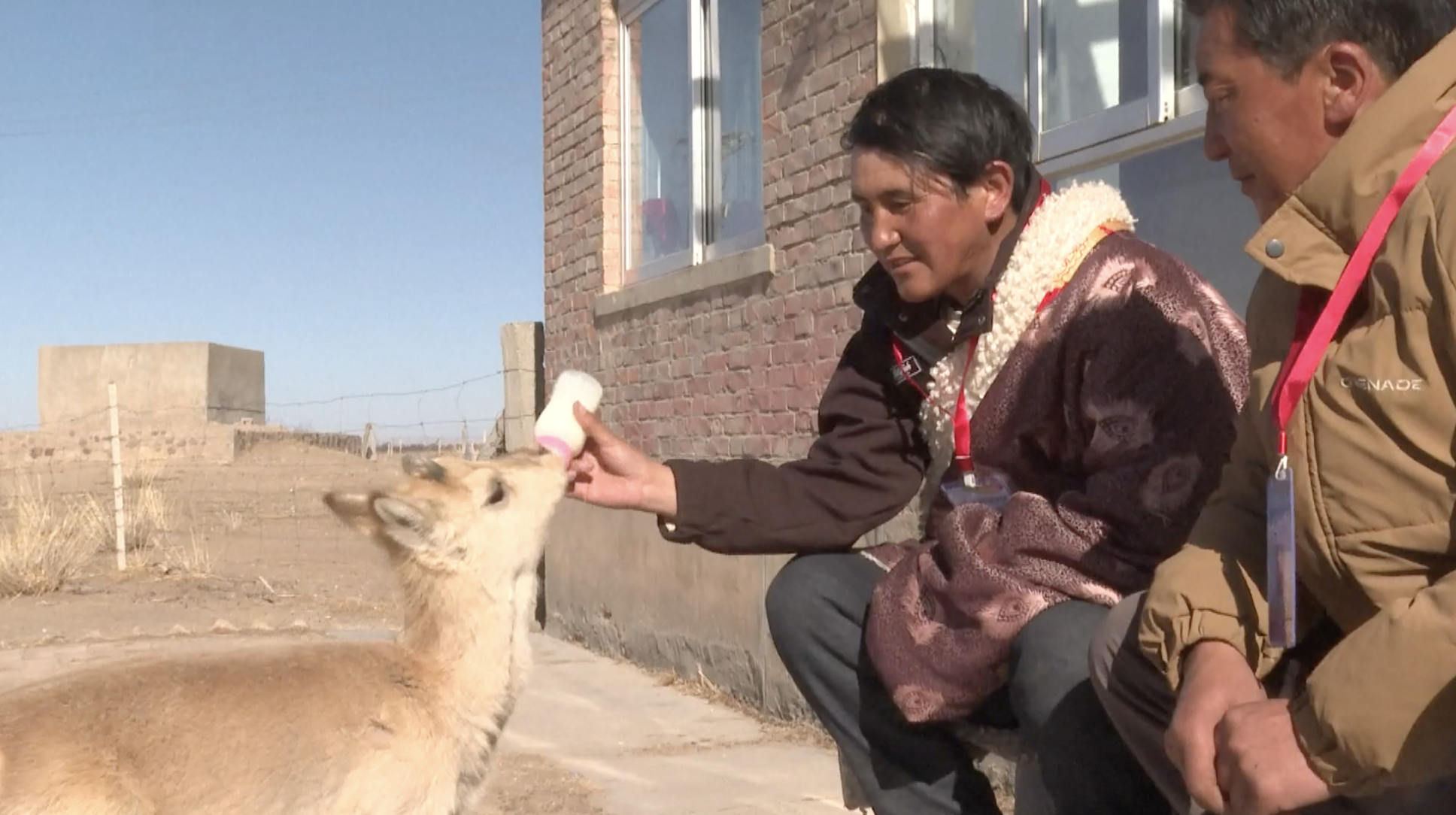01:41

Herdsmen cousins Zhou Zengben and Sonam Tsering, who live in the Haibei Tibetan Autonomous Prefecture of northwest China’s Qinghai Province, have volunteered as guardians for the endangered animal Przewalski’s gazelles since 2016, rescuing dozens of them in routine patrolling throughout the years.
Their idea of protecting the animal began when they saw a heartbreaking scene in which a total of 17 young Przewalski’s gazelles were killed by severe flooding back in 2015. In 2016, the two began to carry out routine patrolling around Qinghai Lake, check on the grasslands and distribute fodder. They would also bring injured or lost young Przewalski’s gazelles back home to take care of them.
The very recent rescue case happened on March 26. Local herdsmen had dragged a baby Przewalski’s gazelle out of a water channel. Not knowing what to do next, they called the cousins for further rescue efforts.
Later that night, the two carried the calf home, lit a stove and turned on a heater to warm it. They also wrapped a blanket around it and decided to stay up all night to monitor the situation of the calf.
“Tonight, we have to stay up all night to keep an eye on the calf. When its wool dries the next morning, we can release it to the wild and then everything will be fine,” said Tsering.
The next morning, the calf was able to stand on its own feet and was then released back to the wild.
The calf marked the 59th Przewalski’s gazelle that the two have rescued over the years.
Many of the rescued gazelles were just-born calves who couldn’t survive independently in the wild. The cousins would take these calves home, feed them, give them names and treat them as their own children.
One of the calves that they rescued and gave a name to is Dorje, who likes drinking milk and is nine months old now.
The period from June to August each year is the calving season for Przewalski’s gazelles. During this period, newly born Przewalski’s gazelle calves can become separated from their mothers.
On a rainy night in July 2023, the cousins discovered Dorje, then just a few days’ old, by a water channel.
“We rescued Dorje on July 16 as I had gone to the field to take a look around. Right in the ditch, there was a small Przewalski’s gazelle. At the time, I thought it had died, but upon closer inspection, it was still alive, barely breathing,” said Tsering.
After a thorough inspection, little Dorje was found to be uninjured but quite weak. With permission from the local forestry police station, Tsering brought Dorje home.
“I found a cardboard box and lined it with my clothes to keep the young gazelle warm. I was afraid I wouldn’t be able to save it. When I brought it home, I fed it milk, drop by drop, into its mouth. Slowly, it began to regain consciousness. The next morning, it was able to stand up on its own,” said Tsering.
Under the careful care of the two cousins, little Dorje is gradually growing up. The cousins plan to release it back into the wild when the grasslands are lush and green in May or June.
To ensure the Przewalski’s gazelles can safely survive the winter, the two cousins often purchase hay at their own expense. They drive a small truck where Przewalski’s gazelles are gathered to distribute the hay.
They also feed them milk from their own yaks. Each calf can consume four to five bottles of milk per day, and they are fed milk for six to seven months before being weaned off it. The cost of feeding these young Przewalski’s gazelles is a significant financial burden on the two.
“I haven’t calculated the cost of milk, but some journalists in town helped me with the calculation. It’s about 20 yuan ($2.7) per kilogram of milk. If it costs about 40 to 50 yuan per day to feed one Przewalski’s gazelle calf, and if you’re feeding one for a year, it would cost around 10,000 yuan to raise it,” said Tsering.
Due to the high milk consumption of the young Przewalski’s gazelles, Zhou decided to sell their 25 yaks and replace them with Simmental cattle, which have a higher milk production capacity.
Currently, the grasslands are experiencing a shortage of continuous greenery, so the two cousins often drive to the grasslands for patrols. Before each departure, they will bring with them tools such as binoculars, a medical kit, notebooks for recording and other necessary equipment. They will record the observations and findings in their patrol logbook in and after each patrolling.
Learning about the story of Zhou and Tsering’s efforts to protect Przewalski’s gazelles, since 2021, the local government has been providing them with free forage for feeding the gazelles. Last year, the local bureau of natural resources and forestry also awarded them the title of “Wildlife Conservation Caretakers.”
“Nowadays, we can see them every day because the population of Przewalski’s gazelles has been increasing year on year. Previously, a group of Przewalski’s gazelles might have been at most 20 or 30 individuals, but now a group can consist of over 100 or even more than 200 individuals,” said Tsering.
The number of Przewalski’s gazelles in the area around Qinghai Lake has increased from over 200 to over 3,400 thanks to the efforts of guardians like the two cousins.
With more and more people joining the protection team, the number of Przewalski’s gazelles is expected to further increase.
